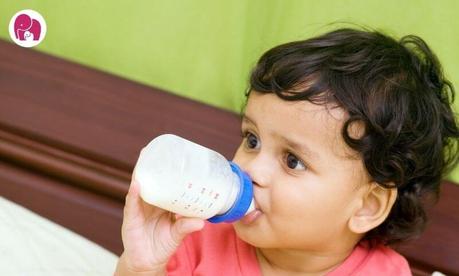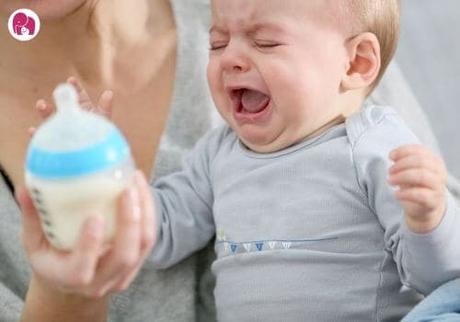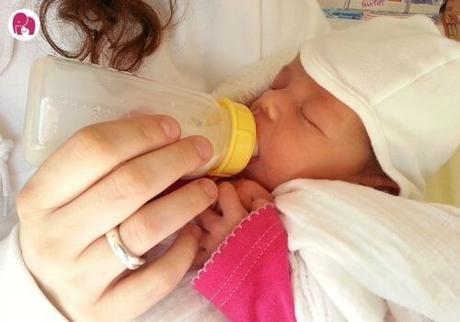bottleSometimes mothers need to use bottle feeding when they need to be away from their babies, be it for work or an outing, or some other reason. Many times it becomes a necessity to feed milk with bottle when the mother produces insufficient milk, has problems like an inverted nipple, cracked nipples, etc, or if the baby finds it difficult to latch properly onto the breast.
If you are a first-time mother, it is normal for you to worry about how to bottle feed, when to start, what to do when babies become "nipple confused", whether formula milk is okay to be given, how much formula milk should be given, what to take care if expressing milk and bottle feeding, etc.

All about Bottle Feeding and How to Feed Milk with Bottle?
Let us discuss one by one all the concerns that parents usually have when thinking of turning to a bottle than the breast.
When to start bottle feeding?
If you are planning to do exclusive bottle feeding then you can start feeding from a bottle right after birth. If you are switching from breastfeeding to bottle-feeding or planning to do mixed feeding, then you might have to use expressed breast milk or use infant formula. In that case, there is no fixed time and you can start bottle feeding when the need arises or any time after a month of the birth of the baby. Waiting at least a month after birth helps to increase the milk supply if you are deciding to give expressed breastmilk.
Before you start with bottle feeding it is important to keep a few points in mind.
- Ensure that the feeding bottle and the teat you are using are sterilized before feeding the baby.
- Breast milk has many nutritive benefits over formula milk. Feeding breast milk will also help your infant to develop immunity and fight allergies and diseases. Hence if bottle feeding, feed expressed milk in a bottle whenever possible.
- Prefer breastmilk, but never get afraid to give formula milk if the need arises. Remember it's all about you and your baby's welfare.
- Read the instructions on baby formula containers about storage and preparation to avoid any infection. Strictly follow the instructions while preparing formula milk.
- Keep the breast pumps and related equipment always sterilized if you are feeding expressed milk in a bottle.
- If you are introducing bottle feeding to your baby just to familiarise him/her with bottle feeding, start with feeding a small quantity initially. This will let you go without interrupting your breastfeeding schedule.
- Always try to prepare fresh formula feeds to avoid infection. If traveling, carry water and formula powder separately and mix just before bottle-feeding
- If traveling with expressed milk, proper storage in cooler bags is necessary. Know all about expressing breast milk, feeding, and storage by clicking here .
- Always discard the leftover infant formula or breastmilk after one hour. Storing and feeding the half-empty bottle's milk is risky and may contaminate as the baby has sucked on it.
Which kind of bottles and teats to choose while bottle feeding?
Whether you are feeding expressed milk or formula milk to your baby, the type of bottle and the teats play a great role in how well the bottle is accepted by the baby.
Different types of bottles such as glass bottles, BPA free plastic bottles, silicone bottle, or plastic bottles with lining are available in the market. Stainless steel feeding bottles are also there in the market.
BPA free plastic bottles and silicone bottles are the most preferred ones as they are lightweight, transparent, and easy to sterilize.
Glass bottles are a bit heavy for little hands to hold and can also shatter if dropped. The benefit of glass is that it doesn't have chemicals that are used in plastic.
Stainless steel bottles are also a good option if you want to avoid plastic. They are durable and easy to clean. But the one problem is that they are not transparent and will make it difficult to keep a track of milk consumed by the baby. Plus they are expensive and not that common in the market.
Feeding bottles are also available in different sizes. You may choose a smaller bottle for newborns and gradually progress to a bigger one as and when the baby starts to consume more milk per feed.
There are different types and shapes of bottles. Some bottle designs are bent at the neck and claim to reduce the air formation in the nipples.
Some have air vents on the nipples to reduce colic in babies. Choose the type of bottle consulting your pediatrician especially if the baby is colicky.
Always choose a shape and design that is easy to clean and hold.
The nipples or teats are usually made with silicone for ease of use, cleaning and sterilization, and safety. Latex nipples are also available but not recommended as latex allergy is a thing that is not that rare.
Different sizes of nipples or teats are available. Ask your pediatrician for the most appropriate teat to be used for your baby. Also, check the size of the hole of the nipple and check the flow of liquid from that.
One hole, slow flow, level 1, etc is used to indicate a nipple that discharges very little milk. These are apt for newborns. Two holes, medium flow, level 2, etc are the names used for teats allowing medium milk flow and are suitable for kids above 3 months. Three-holes, level 3, fast flow is used to indicate when milk is let out at a fast pace. They are apt for babies above 7 months who have become accustomed to bottle feeding.
Nipples come in different shapes too. There are nipples with a wide base and different teat lengths and there are also long nipples with a narrow base. Now what type of nipple your baby will prefer depends totally on him/her. Try experimenting with a few varieties to see what the baby feels comfier to use.
Find a variety of bottles and nipples suitable for your baby by clicking here.
Bottles and teats can be washed with the bottle brush and teat brush respectively with hot and soapy water after each use. They should be sterilized before using it again.
How to prepare formula milk?
If you are not expressing milk, the first thing you would like to do is getting the best infant formula. Baby formula has all the nutrients which your baby requires for growing. You may ask your baby's pediatrician to know the best infant formula for your baby. Prepare the formula by reading the instructions carefully. Always use boiled cool water to avoid waterborne diseases. Never boil formula or add more than the required amount of water or powder. Always take leveled scoops of powder and not heaped. Use a knife to level the powder. Use measuring cups to measure water.
Sterilize all the equipment used for making formula. Store formula powder safely after each use.
How to check the bottle milk flow?
Once you have filled milk in the bottle, check the flow of the milk. To test the flow of the formula or breastmilk, hold the bottle upside down and let the liquid flow out. If the milk drips out steadily from the teat but doesn't pour out, this is the perfect flow for your baby. The flow is too slow if you need to shake the bottle vigorously. If the milk flow is too slow, your baby might not get a sufficient amount of milk.
Check milk flow regularly to make sure the baby is getting the right amount of milk. Less flow may make it difficult for the baby to drink and a heavy flow can choke the baby. Change the nipples as and when the milk flow is not apt or every two months.
If there is little leakage from the corners of the baby's mouth, you need not worry about it. As the baby grows and gets used to bottle feeding, it will stop.
How much bottle feeds should be given to the baby?
Generally, a newborn may take 2 to 3 ounces every 3 hours, and the quantity increases as the baby grow. There are no set numbers or rules on how much expressed milk your baby should be given. Follow your baby's cues and just feed whenever your baby is hungry. Each bottle feeding takes about 20 minutes.
For formula feeding, you can use the guidelines given on the formula tins. Usually, formula-fed babies have less appetite than breastfed babies as formula takes time to digest.
When you introduce solids to your baby, the amount of bottle milk reduces.
Feeding in a cup can be started when your baby is about 6 months old. Cup feeding is aimed to teach the baby how to sip from a cup. This way you can stop bottle feeding by the time your baby is 12 months old. Hence, you also need to reduce the amount of bottle feed, if the baby starts drinking formula milk from a cup instead of a bottle.
How to deal with bottle feeding refusal?

- Too cold milk
- If the position is not right
- If the baby finds it difficult to drink from a bottle due to low flow or overflow
- Nipple confusion
To deal with the refusal of bottle feeding, you can try the tricks like,
- Offer the bottle feeding before the baby is too hungry.
- Keep offering the bottle every half an hour.
- Put expressed breast milk in the bottle.
- Let a few drops of milk drip into the baby's mouth.
- Offer milk when the baby is in a good and happy mood and when you are around.
- Try paced bottle feeding.
If bottle refusal is due to nipple confusion, try changing the nipple. Dipping the teat in formula or breastmilk and then putting it in the baby's mouth can help them be familiar with the nipple and reduce confusion. You will have to patiently introduce the bottle multiple times before baby accepts it.
Paced bottle feeding and the right position to bottle feed
To help babies with bottle feeding, paced bottle feeding is the most recommended one. It is a method in which the baby has more control over the feeding pace.
For paced bottle feeding, hold your baby in an upright position and hold the bottle horizontally. This way, the baby can take lots of pauses and it also lets your baby rest every few minutes. This is to mimic the controlled breastfeeding which they are used to.
Always hold your baby in an upright or semi-upright position when you feed milk with bottle. Never offer bottle feeds when the baby is lying down.
Do I need to warm the formula or breast milk before feeding?
Some babies prefer their bottled milk at room temperature. But most of the time, babies enjoy drinking lukewarm milk. So it is good if the milk is lukewarm while feeding the baby.
Formula or breast milk can be warmed by putting the bottle with the milk in a container containing warm to hot water. Remember not to heat the milk directly on the flame or in the microwave. This might result in curdling and overheating.
Remember to throw away the leftover milk or formula after each feeding as it poses the risks of contamination.
Advantages and Disadvantages of Bottle Feeding

If you have started bottle feeding, here are the benefits your baby and you would enjoy because of bottle feeding.
Advantages
- You get to know exactly how much food is necessary for your baby to feel full.
- Formula-fed babies demand the food less often as formula milk remains in the tummy for more time and digests slowly.
- Everyone in the family can involve in feeding the baby.
Disadvantages
All the coins have two sides. Bottle feeding too has its cons.
- Sometimes babies fall asleep while feeding. This may result in drawing the milk into the lungs which may result in choking.
- If a baby falls asleep with a bottle in the mouth or is bottle-feeding for too long, it may result in tooth decay.
- If the baby is bottle-fed while lying flat, milk can flow into the ear and cause an ear infection.
- Sterilization, expressing milk, or preparing formula consumes time.
There are both pros and cons. However, the cons can be avoided by maintaining precautions and hygiene in infants. Although it is a fact that breastfeeding is the best for the baby's growth and development, you must remember that breast or bottle, it is awesome as far as you are feeding your baby with love.
Don't forget to comment here on how you started bottle feeding and what all difficulties you faced. Happy bonding with your little one!!
